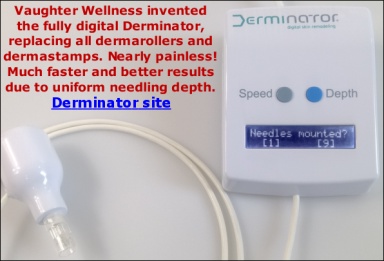Dermarolling / Microneedling / 70% improvement of stretch marks after 3-4 rollings. True?
« on: August 11, 2010, 05:19:42 PM »>My name is [deleted], I'm 22 years old from Beirut, Lebanon.
>Throughout the last year, I have lost about 20 kgs in 3 months, and as a
>result i got stretchmarks on my upper arms, thighs, breasts,a nd hips.
>I wanted to undergo the original 1.5 mm dermaroller treatment by a
>doctor, but ifound it extremely expensive.
>After researching, i came across your website.
>I'm very interested in buying your dermaroller kit. However, something is
>really confusing me.
>On the original dermaroller website,medical doctors saidthat 3-4 rolling
>sessions 6 weeks apart
>would result in at least 70%improvement in stretchmarks.
>In your website,you said that improvement cannot be noticeable until a year or so.You didn't provide any cumulative percentage for the improvement.
>Can you please inform me regarding my expectations, especially that i want
>to get married next Fall,and i really would like to wear a strapless >wedding dress. So I hope your dermaroller would be helping me in this.
Hi [deleted],
Sorry for my delayed answer. I was on holidays.
First of all, congratulations with you wedding and with your weight loss (provided it was intended). You must be a pretty girl.
The problem with stretch marks is that they go through the entire epidermis and most of the dermis, which is quite deep. Stretch marks are cracks in the skin, filled with scar tissue. There is currently no method that can totally remove stretch marks. If somebody tells you so, he is lying :-)
A dermaroller in combination with single needling can dramatically improve the stretch marks but it cannot remove them. The extend of improvement is highly individual and such claims that ALL customers will always achieve at least 70% improvement are totally unsubstantiated so they're simply a marketing trick. They are lies. At least 70% improvement means that the stretch marks are almost gone in all their customers. That is totally impossible.
Some of our customers achieved very good results. The stretch marks are still there but much less visible, their texture improved and they blended more with the surrounding skin - color-wise. Some customers achieved an improvement very quickly (2 months), some much later and some none at all.
This is our most successful stretch mark improvement customer:
https://http://www.owndoc.com/stretchmarks/stretchmarks-single-needle-before-and-after/
It means that such improvement is possible but it doesn't mean that everybody achieves it. You have to do your best to achieve it and you might succeed but I cannot make promises because nobody knows why it works with some people and with some it doesn't. The same with laser, acid peels, facelifts etc. Not everybody achieves the same level of improvement.
If you want me to promise you that by this fall, your stretch marks will be 70% improved with a dermaroller - well I can't so in that case it's better not to buy from us. I prefer to be honest and say you may achieve results pretty soon but usually it is not that easy and lots of perseverance and patience is needed.
Is the color of your stretch marks red or white?
The only way to quickly achieve improvement for your wedding day is to roll the stretchmarks just before it. The skin usually remains red for one day and it makes the stretchmarks temporarily less visible. This is not a permanent improvement - this is just a temporary inflammation that makes the skin bit red.
You would of course have to try it for a long time prior to the wedding and find out how your skin reacts. If the stretch marks indeed do look less visible for 24 hours or if it actually makes them more pronounced etc. You would have to experiment a little.
If you want a permanent improvement, you will have to be patient and keep on rolling with 1.5 mm + single-needling + using vit. C serum.
Sorry that I do not have better news for you..
Best regards,
Sarah





